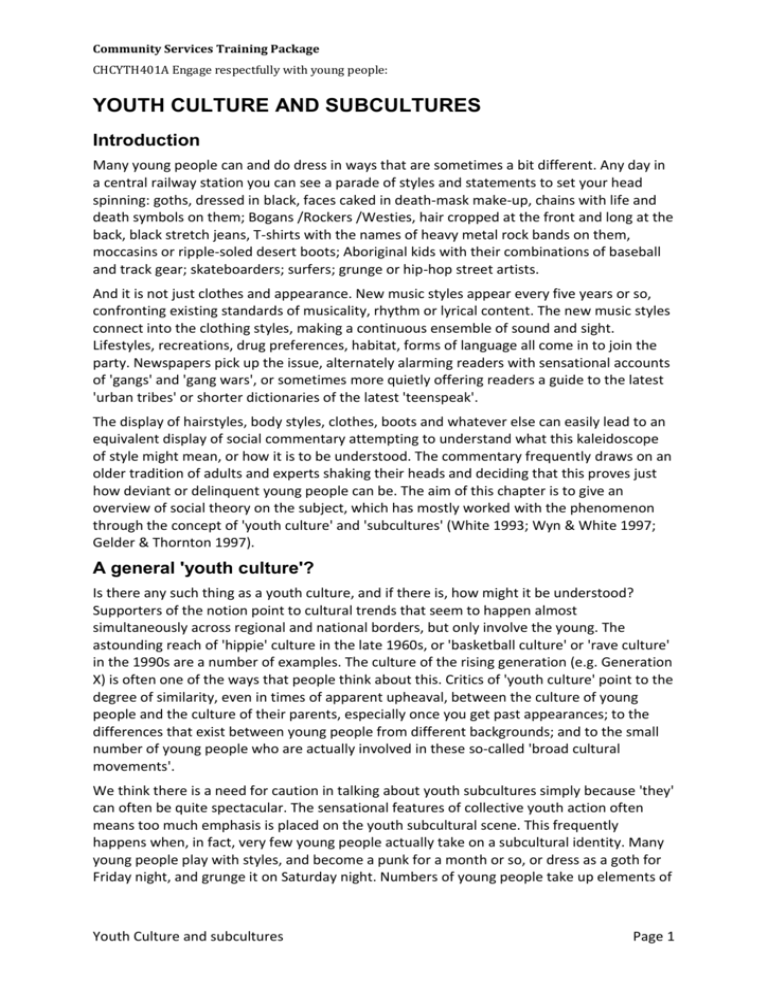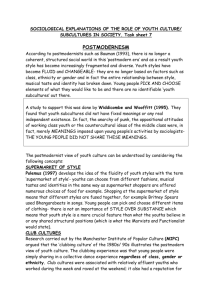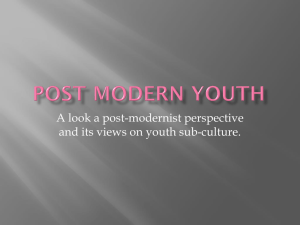Youth Culture and Subcultures
advertisement

Community Services Training Package CHCYTH401A Engage respectfully with young people: YOUTH CULTURE AND SUBCULTURES Introduction Many young people can and do dress in ways that are sometimes a bit different. Any day in a central railway station you can see a parade of styles and statements to set your head spinning: goths, dressed in black, faces caked in death-mask make-up, chains with life and death symbols on them; Bogans /Rockers /Westies, hair cropped at the front and long at the back, black stretch jeans, T-shirts with the names of heavy metal rock bands on them, moccasins or ripple-soled desert boots; Aboriginal kids with their combinations of baseball and track gear; skateboarders; surfers; grunge or hip-hop street artists. And it is not just clothes and appearance. New music styles appear every five years or so, confronting existing standards of musicality, rhythm or lyrical content. The new music styles connect into the clothing styles, making a continuous ensemble of sound and sight. Lifestyles, recreations, drug preferences, habitat, forms of language all come in to join the party. Newspapers pick up the issue, alternately alarming readers with sensational accounts of 'gangs' and 'gang wars', or sometimes more quietly offering readers a guide to the latest 'urban tribes' or shorter dictionaries of the latest 'teenspeak'. The display of hairstyles, body styles, clothes, boots and whatever else can easily lead to an equivalent display of social commentary attempting to understand what this kaleidoscope of style might mean, or how it is to be understood. The commentary frequently draws on an older tradition of adults and experts shaking their heads and deciding that this proves just how deviant or delinquent young people can be. The aim of this chapter is to give an overview of social theory on the subject, which has mostly worked with the phenomenon through the concept of 'youth culture' and 'subcultures' (White 1993; Wyn & White 1997; Gelder & Thornton 1997). A general 'youth culture'? Is there any such thing as a youth culture, and if there is, how might it be understood? Supporters of the notion point to cultural trends that seem to happen almost simultaneously across regional and national borders, but only involve the young. The astounding reach of 'hippie' culture in the late 1960s, or 'basketball culture' or 'rave culture' in the 1990s are a number of examples. The culture of the rising generation (e.g. Generation X) is often one of the ways that people think about this. Critics of 'youth culture' point to the degree of similarity, even in times of apparent upheaval, between the culture of young people and the culture of their parents, especially once you get past appearances; to the differences that exist between young people from different backgrounds; and to the small number of young people who are actually involved in these so-called 'broad cultural movements'. We think there is a need for caution in talking about youth subcultures simply because 'they' can often be quite spectacular. The sensational features of collective youth action often means too much emphasis is placed on the youth subcultural scene. This frequently happens when, in fact, very few young people actually take on a subcultural identity. Many young people play with styles, and become a punk for a month or so, or dress as a goth for Friday night, and grunge it on Saturday night. Numbers of young people take up elements of Youth Culture and subcultures Page 1 Community Services Training Package CHCYTH401A Engage respectfully with young people: different styles and quite regularly features of particular subcultural groups become mainstream fashion. Most young people, however, are entirely conventional. This is also true of broad youth cultural expression. While young people have dressed differently from their parents — at least since the 1950s — research indicates that their values, political ideas, beliefs and aspirations have a lot in common with their parents — much more than with other young people from a different background. The idea of a 'generation gap' or a 'universal youth culture' is often an exaggeration. Analytically, there are a couple of concepts which need to be clarified. When we talk about a youth culture, are we talking about something that is specific to a particular generation, or something that is specific to a particular age group? There is a difference: you grow out of an age group; you don't grow out of a generation. People who are now in their mid-forties are still part of the '1960s generation', the 'baby boomers'. People in their fifties are still the 'postwar generation', and those in their late sixties and seventies are from the 'wartime generation' or 'depression generation'. Generations and social change The idea that youth cultures come in age-specific packages has been around since Karl Mannheim's studies of the 1920s generation. His influential essay, 'The problem of generations' (1928) argued that the generational phenomenon existed because a given group of young people grew up at a time of rapid social change. The circumstances of their lives, and the ideologies/ culture they develop to deal with these changes, give this cohort of people a common culture which is different from their parents and their children. Such experiences may — but not necessarily will — give rise to a 'new generation style, or ... a new generation entelechy' (Mannheim 1957, p. 309). Smith (1983, p. 5) called this ideological stamp 'historico-cultural imprinting'. Current popular sociological discourse about the 'baby boomers', the 'Woodstock generation' or 'Generation V is simply a modern version of this idea. For Mannheim, however, and unlike pop sociology, this may not just be a matter of young versus old, or a 'Generation V. Different social groups have different experiences even of universal social experiences like the First World War, as, indeed, do different individuals of different personalities or dispositions (Mannheim 1957, p. 316). He acknowledged that generational cultures may impact on societies as one of several factors at particular points of their history, but argued that there is nothing inevitable about it. As he argued, the generational factor — which at the biological level operates with all the uniformity of a natural law — becomes quite elusive at the social and cultural levels, where its effects can be ascertained only with great difficulty (Mannheim 1957, p. 320). Being a product of a particular historical period, subject to widespread social forces like war, depression, nationalist uprisings or revolution, can have a significant impact on people. It is not unlikely that age is a factor here, because of the way that people are placed by age in certain social and institutional locations. People are conscripted for war duty by age, leave home to tramp the roads in search of work by age, or are enrolled at universities by age. So it may often happen that a particular cohort of young people together share the effects of a common experience or situation, or draw from a common stock of ideas and images. However Mannheim urges caution: the degree to which people of a common generation share a common culture is easily exaggerated. Today, a term like 'Generation X' is a Youth Culture and subcultures Page 2 Community Services Training Package CHCYTH401A Engage respectfully with young people: nonsense term. It is saying that there is no generational consciousness in the generation that grew up in the 1980s. Or, in other words, the term 'Generation X' means that there is no Generation X. According to Mannheim, this is not remarkable, since the lack of a generational consciousness is the rule rather than the exception. A number of other people have worked with the idea of generation but in a slightly different way. Theorists like Kenneth Keniston (1968, 1971), Herbert Marcuse (1972), and, in Australia, David Pyvis (1991), have considered generational succession as the engine of social change. Earlier, Ortega Y. Gasset had argued that youth had supplanted the working class as the vehicle of social progress in the 1920s, and that generational succession had replaced the class struggle as the fundamental dynamic of change (Springhall 1984, p. 22). Age-based youth cultures The other major approach to the idea of a general youth culture begins with the work of sociologists working in the functionalist tradition. In 1942 Talcott Parsons suggested that there was a significant difference between the cultural values of American high school students and mainstream America. Parsons argued that a distinct youth culture operated in American high schools, in which the role that young people took was 'more or less specifically irresponsible'. Youth culture valued athleticism for boys and physical attractiveness (the 'glamour girl' role) for girls, often at the limits of (or beyond) parental approval, and contravening mainstream values of hard work and sobriety. However, he saw this cultural development as functional in helping people adjust to adult roles, and especially to preparing women for their roles in the family and in support of their husbands' careers. Coleman's work in The Adolescent Society (1961), also located in high schools, came to similar conclusions, arguing that these values, along with the focus on 'having a good time' noted by Parsons, established the youth culture as a specific 'subsociety'. This line of argument was followed up in more detail by S. N. Eisenstadt. According to Eisenstadt, the role of age groupings in what he called universalistic (i.e. non-kinship based) societies is to integrate family structures with broader political and economic structures. This role has become necessary because kin-based and familial institutions have become 'private', divorced from economic and political functions. This means that there is a risk of social disintegration in such societies. However, how effective age-structures are in integrating the private structures of the family and the public structures of economics and politics depends on a number of preconditions: (a) the extent of harmony between the values and orientations of age groups and the basic institutional norms and values of the social structure —compatibility which manifests itself in ... smooth interaction with other generations, (b) the extent to which the identity evolved through participation in age groups is adequate for attaining full social status; and (c) the extent to which fully institutionalised roles are allocated to age groups (Eisenstadt 1956, pp. 276-77). In other words, 'youth' as a social structure is functional if the age grouping has clear economic, political and ceremonial roles. Eisenstadt argues that failure in any of these areas will result in deviant youth groupings, including unorganised or organised groups of delinquent youth, youth organisations of revolutionary movements and parties, and Youth Culture and subcultures Page 3 Community Services Training Package CHCYTH401A Engage respectfully with young people: rebellious (cultural) youth movements such as the Wandervogel and other German youth movements of the late nineteenth and early twentieth centuries. He goes on to suggest that most modern societies do not meet these prerequisites. Values are diverse, youth groups do not guarantee adult accreditation and have no clear social role. In other words, youth groups are excluded from economic and social participation. As a result, Eisenstadt argues that youth groups have routinely become deviant. However this cloud might have a silver lining. In agreement with generational analysis, Eisenstadt argues that this deviance may make youth groups one of the more important means by which the numerous changes characteristic of modern societies take place (Eisenstadt 1956, p. 323). The idea of a generalised youth culture became particularly popular in the late 1960s and early 1970s with the emergence of the 'counterculture' or 'hippie' movement. In the USA, Britain, France, Holland, Germany, Japan and Australia, students almost simultaneously began organising protests about university reform, the Vietnam War, nuclear arms and environmental damage, and challenging 'Establishment' values of domination, aggression and materialism. While this movement was often understood in terms of generational culture (the idea of a 'generation gap' became popular here) the international, and seemingly universal nature of the movement lent itself to the idea of a universal age-based youth culture. Kenneth Keniston, a social psychologist working in the context of the student radicalism of the 1960s, argued that youth was a universal psycho-biological 'stage of life' between adolescence and adulthood, characterised by 'the tension between selfhood and the existing order' (1968, p. 3). In his view, this stage was something new, emerging only under the conditions of affluence prevalent in the 'long boom' of the postwar period, which had allowed large numbers of young people to continue study and therefore, by delaying the discipline of economic necessity, to extend their psychological development. This new stage creates on a mass scale, a 'new' breed of people whose psychological development not only inclines them to be critics of our own society, but might even make them potential members or architects of a better one than ours (Keniston 1988, p. 3). This theme of an idealised, noble youth bringing in the new day of moral purification, whether in terms of equality, liberty and fraternity or some other position, is a recurring theme in writing about young people. It is the other side of the coin of delinquent images of youth, and like those images, it is a fantasy with its origins in the need of adults rather than in the reality of youth. The major challenge to this came in the resurgent neo-Marxist critique which gained momentum from the mid-1970s through to the late 1980s. At Birmingham University, a new research centre had developed which was applying some of the new interpretations of Marx to questions of culture, crime, literature, art, the media, and politics. While it was not an exclusive interest, the Centre for Contemporary Cultural Studies (CCCS) as it came to be known took an active interest in youth culture and subculture, an interest which culminated in the classic Resistance Through Rituals edited collection. Writers associated with the Centre took to task the categories of the youth versus adult, hip versus square, counterculture versus Establishment frame that were popular, and refocussed the debate on class (see Hall et al. 1976a, b). Noting that the so-called universal youth culture was in fact restricted to a very small proportion of young people, and that most of them were students and middle class, the CCCS argued that the differences between the cultures of young people, depending on Youth Culture and subcultures Page 4 Community Services Training Package CHCYTH401A Engage respectfully with young people: whether they were middle class or working class, black, white, were much more significant than the surface similarities of dress and language. Conversely, research from more conservative origins on the 'generation gap' confirmed that the similarities in values between young people and their parents were much more significant than their differences, except for pre-marital sex —and the parents were probably lying about their own behaviour in that regard. Even the hippie generation believed the same things as their parents. The apparent differences were largely due to the parents becoming used to the injustices and racism of the political system while the students, probably because they had less to lose, acted on the liberal values that both shared. Within the approach fostered by the CCCS, the differences between the youth culture and the adult culture could be put down to institutional setting. Young people were at school, adults were not. Young people developed adaptive cultural responses to deal with the unique power relations within the school (both with teachers and other students) and with the work processes of the school. Closer analysis revealed that under the surface, their modes of dealing with the school were much more like their parents than might at first appear. Willis' classic study Learning to Labour, for instance traced the similarities between the forms of resistance employed by working class boys in school and those prevalent on the factory floor. On reflection, even Talcott Parsons' analysis of high school culture revealed much more similarity than he recognised. For instance, while the values of young men centred around athleticism and the values of their fathers around hard work, both were really about an aggressive male competitiveness. The difference was that the content of the culture was prescribed by the school versus business setting. The form of the culture was nevertheless remarkably consistent. The real cultural difference was between the middle class, for whom school was a passport to social status and success, and the working class, for whom resistance at school prescribed a destination on the factory floor. This class dichotomy was reinforced by the fact the schools were planned, run and controlled by the middle class, and the language, values and culture of the school were foreign to working class children. For the Birmingham theorists, then, youth cultures were expressive of a deeper and broader class conflict that structured the whole of capitalist society. Youth culture could therefore be understood only in the light of class culture and the history of class struggle. This shaped their response to the study of youth subcultures as well. Youth subcultures The late 1960s and early 1970s had given rise to a number of spectacular subcultural styles in Britain, including the Teddy Boy, Mod, Rocker, Skinhead, Punk, New Romantic, Rasta and Glamrock styles. A succession of theorists sought to understand the emergence of these subcultures (and the sometimes frantic social reaction) from a class analysis perspective. The CCCS was at the forefront of this research. What the CCCS was trying to do was to interpret cultural forms, including subcultural forms, in terms of resistance to class domination. In Resistance Through Rituals, the Centre's classic work on subcultures, youth subcultures arise as 'negotiated solutions' to the imposition of discipline and to the contradictions between dominant ideology, the class-based ideologies of their parents, the ideologies arising from their different institutional location in the Youth Culture and subcultures Page 5 Community Services Training Package CHCYTH401A Engage respectfully with young people: school, in apprenticeship, in training programs, and the more specific local and personal ways of shaping their social world. In the analysis by Clarke et al. subcultural styles 'win space' for the young, allowing working class young people to modify, subvert or accommodate dominant ideologies without needing to reject them outright (Smith 1981, p. 240ff). Cohen's analysis of subcultures similarly represented the development of subcultural styles as an attempt 'to express and resolve, albeit magically, the contradictions that remain hidden or unresolved in the parent culture' (in Hall et al. 1976, p. 32). Dick Hebdige (1979) took the analysis further to apply the emerging discipline of semiotics (the study of symbols) to analyse in detail the symbolism tied up in the clothes, music, language, drugs and occupations of subcultural styles. One of the clearest examples of the CCCS approach was John Clarke's work on skinheads (Hall et al. 1976). Clarke grounded the skinhead phenomenon in the social dislocation and anxiety surrounding the dismantling of inner-city working class communities and their relocation to high rise housing estates and satellite towns on the fringes of major cities, combined with growing unemployment and working class resentment of recently arrived migrants (in this case, the Pakistanis). Clarke suggested that the skinhead phenomenon sought to defend traditional working class male prerogatives. The Doc Martens boot, the jeans, the cropped hair were in fact stylised and exaggerated expressions of industrial working clothes. The self-conscious and aggressive working class identity, the patriotism (and xenophobia!), the 'hard man' values that celebrated the aggressive commitment of the body either to the fight or to physical labour were all cultural components that ran deep within the parent culture. Clarke argued that skinhead culture was a reaction against bureaucratically imposed change, against economic marginalisation, against class oppression, against the destruction of communities, and against the passive acceptance and ineffectualness of their parents. That the outlet for their protest was violence against homosexuals and Asian migrants was distressing, but values about violence, homophobia and racism are alive and kicking under the surface, not only within the parent working class culture, but in the dominant mainstream as well. The notion of subcultures being an attempt to express and resolve contradictions within and between ideologies, to 'win space' in order to be able to negotiate with dominant and parental cultures, and to symbolically express resistance to the established order continues to be used by some Australian writers (White 1990) to identify and explain subcultural styles. The CCCS approach is by no means the only attempt to theorise youth subcultures. However, most studies of youth subcultures have been largely descriptive, documenting the major features of the subculture, rather than developing explanations. Where explanations have been offered, they have tended to be local and particular to that group. That is by no means a bad thing, but it does make it difficult to apply as an approach to other situations. What is useful about the Centre's perspective is that you can at least use it as a starting point, or even a point of departure, for understanding youth subcultures. On the other hand, it is precisely the claim for general application implicit in the CCCS's class analysis that has come under attack from critics. Critiques of the CCCS approach have come both from feminist and post-structuralist directions. Angela McRobbie (1976) argued that their subcultural analysis, because of its focus on spectacular cultures that are male dominated, Youth Culture and subcultures Page 6 Community Services Training Package CHCYTH401A Engage respectfully with young people: has once again rendered girls invisible. Girls are mostly excluded from street culture, and contained and controlled much more extensively within the home, by the fear of rape. Some feminist commentators have observed that much of the cultural expression of girls is a 'bedroom culture'. Because this is a private world, it has been much less open to researchers than the public space of the street corner. Others have argued that girls can engage in public expressions of violence and expressive action (Carrington 1993). From a post-structuralist perspective, Gordon Tait and others have argued that the focus on class similarly obscures other dimensions of the youth phenomenon. This is an interesting reversal of the CCCS critique of functionalist sociology and its focus on youth. Tait suggests that the CCCS approach to youth subcultures is not able to comprehend the complexity and diversity of the youth phenomenon because it wants to pull everything back to class relations, and because it misunderstands the operation of power. He argues that all the various styles of young people's activities cannot be added up and turned into a generalised, working-class opposition to the power of the ruling classes. Tait insists that most forms of resistance develop in highly specific and different ways usually in response to specific modes of domination, through diverse domains and situations (Tait 1993, p. 5). The problem, he suggests, is this 'totalising' approach of Marxism theory of everything. Rejecting Marxism's big-picture view, he argues that post-structuralist theory, with its interest in local and particular situations, is more useful in the analysis of youth subcultures and less prone to distorting what is really going on in order to fit it into the frame of class struggle. Current interest in youth subcultures has not reached the preoccupation of the 1970s, so the promise offered by post-structuralist approaches has yet to be fulfilled. Researchers have been active in other areas, especially in studies of the media, history and social policy, but subcultural studies from this perspective have been thin on the ground. However, it is probably true to say that neo-Marxist and post-structuralist explanations have a lot more in common than they realise. Both, for example, think that the central problem is not youth, but the social processes by which youth is constituted as a social category, the study of the institutions and discourses through which young people are classified and controlled, and of the forms of resistance and self-formation that young people engage in. The essential difference between them is that the neoMarxists stay with explanations located in the large structures of class, global dynamics of societies and economic trends. Post-structuralism brings into focus everyday, peripheral practices of social interaction. Perspectives that draw on the work of Foucault are interested in how young people are constructed as youth, in descriptions of the techniques of governance that constitute young people and police their lives. Neo-Marxist approaches are more interested in why they are constructed so, who are the agents of this construction, and where this construction locates young people in relation to other sets of social practices and to the overall society. One of the central interests in post-structuralist theory is the way that language is employed to establish an identity, a social classification of people that can then be controlled. Such languages (called 'discourses' in the theory) are not just invented by the powerful and imposed on the powerless; the process is more complex than that. For example, Foucault talks about the ways that subject populations themselves take on an identity and participate in the development of discourses around their population group. Subcultures can also therefore be understood as one of the ways that young people themselves forge the Youth Culture and subcultures Page 7 Community Services Training Package CHCYTH401A Engage respectfully with young people: category of 'youth'. This is especially interesting in the ways that young people latch onto, consume, and often invent, new styles and artefacts that express their feelings about the world. The spread of such styles across different communities, especially since the transport and communications revolution of the last few decades, is one of the things that makes the idea of a universal youth culture attractive. Youth culture and the teenage marketplace The term 'teenager' emerged in America in the period immediately after the Second World War. It signalled a new self-consciousness about the status of young people, and its expression in music, clothes and leisure pursuits: a creation — in leisure and cultural consumption — of a youthful 'identity'. As the Dictionary of American Slang notes, the USA is the only country in the world that has a word for members of this age group, and it is also the only country considering this age group as a separate identity whose influence, fads and fashions are worthy of discussion apart from the adult world. It notes that before around 1935 US 'teenagers' considered themselves as, and were considered, young adults and not a special group (in Doherty 1988, p. 44). Doherty argues that the uniqueness of the teenage phenomenon is not just due to the unique situation of the generation born in the war, or to the demographic phenomenon of the postwar baby boom that put large numbers of people in a single age cohort onto the world stage at the same time, or just to the increasing affluence of that generation living in the 'long boom'. What lent 1950s teenagers a sense of group identity both peculiarly intense and historically new was that their generational status, their social position as teenagers, was carefully nurtured and vigorously reinforced by the adult institutions around them. In the marketplace and the media, at home and at school, the teenager was counted a special animal requiring special handling ... (Stratton 1992). For the first time, the essentially private psychological and physical development of the American adolescent was accorded a dramatically public recognition. At once socially special and specially socialised, 1950s teenagers experienced the same things together — through their assigned place in the burgeoning consumer economy, in the increasing uniformity of public school education and in national media that doted on their idiosyncrasies (Doherty 1988, p. 46). Surprisingly, business was slow to recognise the potential for profit offered by a burgeoning population of young people, with historically high levels of disposable income, in a market offering a new variety of consumer goods, from records to clothes to holidays to private transport (Doherty 1988, p. 66). Significantly, this was because the dominant popular construction of youth was still that of the juvenile delinquent. Postwar moral panics about juvenile crime were still fresh in the minds of the general population. Styles favoured by young people therefore carried with them the smell of delinquency (Johnson 1993). Young people's tastes in music increasingly leant towards the black side of town, the voice of the 'Other', a trend that had been apparent since the 1920s fascination with jazz. Initially, entrepreneurs sought to reverse this movement from the supply end. Movie houses refused to cater for the tastes of young postwar people, offering 'family entertainment' instead. Radio stations tried to establish musical forms like the polka in order to displace emerging black rhythm and blues styles (Doherty 1988, p. 56). But eventually, the failure of such moves, and the obvious dependence that media and fashion houses had on the Youth Culture and subcultures Page 8 Community Services Training Package CHCYTH401A Engage respectfully with young people: disposable incomes of young people, led capital to accept the inevitable and market the kinds of goods that young tastes demanded. Once the ice was broken, a flood of consumer items especially for the young came onto the market. While control never moved out of the hands of adults, and while continuous rearguard actions in favour of 'decent' films, music and other cultural products were mounted, it became increasingly possible for teenagers to construct a teenage identity based on products bought in the teenage marketplace. The market was supplying symbolic goods enabling young people to construct themselves as teenagers. Some commentators (e.g. Abrams 1959) have concluded from this link between the emergence of the teenage phenomenon and the availability of teenage consumer goods, that the youth phenomenon has been created by entrepreneurs for the purpose of selling goods, or rather more gently, that youth is a consumption class. The relationship is probably more complex than this. Frequently, some cultural artefact, some symbolic good, is created or adopted by a group of young people as a symbol of shock or protest against the established order or some element of it, as a way to 'win space' (Smith 1981, p. 240). Blue jeans, Doc Martens boots, safety pin jewellery, flowers, beads, dreadlocks, punk music, black music, hiphop and rap started this way. For some young people, the language of protest, anger, rebellion or revolt expresses what they feel, and styles are adopted, venues and products patronised. Youth market entrepreneurs, by now ever alert for the 'new sound' or the 'new look', take up and market such styles not only to meet the existing market — the subcultural market — but to recycle these symbolic goods into a wider, less alienated, more affluent market, these often being not only other young people but adults too. The symbolic content of such goods is then transformed in the shift of context. Often the marketing of such styles simply connotes youth itself as an artefact to be bought and worn. Brando leather jackets became a symbol of rugged individualist masculinity. Plastic garbage bags became chic. Clothes, music, styles connote a radical edge, a selfconscious statement, but now isolated from political content and context. Malcolm X merchandising among young people who don't know who Malcolm X was and would not agree with him if they did, is a contemporary example. The face and the name become contentless expressions of anger and rebellion. In this way, young people isolated from the originating context can appropriate a style that says youth, or freedom, or rebellion, or the 'other', and engage in the continuous selfformation of themselves as youth, distinct from the oldies who have only just learnt to understand and accept the style from three style shifts ago. Styles themselves have a short shelf-life. The take-over and commercialisation of symbols of radicalism ensures that the radical content is rapidly depreciated, transformed into the mundane. As a result, the teenage market is ever on the alert for the new sound, the new look, the new icon which is able to refresh the category and generate new marketing angles. And groups of young people, living under objective conditions of oppression, continue to invent or adapt cultural artefacts to meet their own needs, 'to express and resolve, albeit magically, the contradictions that remain hidden or unresolved in the parent culture' (Hall et al. 1976, p. 32). Young people are involved in their own construction of a youth identity in all sorts of ways. The self-formation of youth as students, or as delinquents, is arguably more central than any subcultural expressions. However, they do serve to illustrate certain components of the Youth Culture and subcultures Page 9 Community Services Training Package CHCYTH401A Engage respectfully with young people: process by which the constitution of youth as a subject is achieved. Perhaps most interesting is the play between adults and young people in the process. In the consumption of youth style, the ownership and marketing of commodities of youth culture lies with adults. However, the genesis of the style often begins with small groups of young people working with small independent producers, and it is the sovereignty of the young consumer that will determine what will take off and when. That this process cannot be dictated by the parent generation is amply illustrated by the attempt to establish the polka as the new dance craze in 1956 (Doherty 1988, p. 56), and the attempt to reinstate the Andy Hardy 'family movie' in 1958 (pp. 182-83). Conclusion The idea that there is a specific youth culture, sometimes expressed as 'spectacular' youth subcultures, has been understood in several ways. There has been debate as to how useful the idea is, given the extent to which young people's values are similar to their parents, and given the differences that exist between young people. The observable differences in culture may be due to the fact that young people occupy different places in society and inhabit different institutions from their parents, so cultures are expressed differently. It may also be that youth as a social structure performs important integrative functions for the society as a whole. These may include the integration of social change. Also, we need to understand the extent to which these differences are a function of generation rather than age, a product of the different times in which people grew up. Again, however, we need to be cautious in generalising about the cultures of a particular generation. Mostly generations do not share a single culture. The more visible expressions of youth cultures in subcultural styles have been understood in a number of ways. They are an attempt to win space from the dominant culture. They are an attempt to symbolically express and resolve the contradictions that they experience between different cultural and ideological forces: between dominant ideologies, parent ideologies, the ideologies that arise from their own daily lives. Cultural forms and artefacts that originate with young people are also taken over by the vast youth culture industry, constantly on the lookout for the 'new sound' or the 'new look'. These styles are then sold to other young people for whom they may carry different meanings. Styles, both appropriated and invented, are used by young people in the process of self-definition, self-invention and self-formation as youth. In all this, we need to be aware that most young people are entirely conventional, and do not participate to any significant degree in sub cultural groups. They may 'play' with styles and looks, but rarely develop a consistent sub cultural identity. Youth Culture and subcultures Page 10







